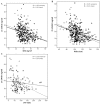Lipid accumulation product and 25-OH-vitamin D deficiency in type 2 diabetes
- PMID: 24841878
- PMCID: PMC4160011
- DOI: 10.1900/RDS.2013.10.243
Lipid accumulation product and 25-OH-vitamin D deficiency in type 2 diabetes
Abstract
Background: Emerging data suggest a link between vitamin D (25(OH)D) deficiency, type 2 diabetes (T2D), and visceral adiposity. The lipid accumulation product (LAP), strictly correlated with abdominal fat depots, is proposed as marker of dysfunctional adiposity.
Aim: To verify the association between 25(OH)D levels and LAP in T2D.
Methods: Body mass index (BMI), waist circumference (WC), glucose, HbA1c, lipids, and 25(OH)D were assessed in 420 T2D outpatients and in 150 non-diabetic obese with similar anthropometric characteristics. LAP was computed as the product of sex-specific enlarged WC and triglycerides (TG).
Results: In T2D patients, 63.0% showed 25(OH)D deficiency (<20 ng/ml) vs. 71.3% in the obese control group. Overweight males showed a higher prevalence of 25(OH)D deficiency (60.3%) than women (48.8%, p < 0.001), while in obese patients this prevalence was not significant. In both genders, 25(OH)D was not significantly associated with HbA1c and fasting glucose. Age-adjusted 25(OH)D levels were inversely correlated with BMI (p < 0.001), WC (p < 0.001), and LAP (p < 0.001) in both genders. Metabolic syndrome presented an odds ratio (OR) for 25(OH)D deficiency of 1.6 (1.1-2.5, p = 0.048) in females and 1.7 (1.2-2.7, p = 0.016) in males, while the highest quartile of LAP showed an OR of 2.1 (1.2-3.6, p = 0.019) in females and 3.2 (1.6-6.5, p = 0.02) in males. A similar trend was observed in the obese control group.
Conclusions: In the presence of excess weight, subjects with and without T2D frequently feature low 25(OH)D levels. Subjects with higher LAP exhibit a high risk of 25(OH)D deficiency, suggesting that dysfunctional adiposity is a worsening factor for vitamin D hypovitaminosis.
Figures


Similar articles
-
Association Between 25-Hydroxyvitamin D and Epicardial Adipose Tissue in Chinese Non-Obese Patients with Type 2 Diabetes.Med Sci Monit. 2017 Sep 6;23:4304-4311. doi: 10.12659/msm.904755. Med Sci Monit. 2017. PMID: 28877159 Free PMC article.
-
Visceral Adiposity Measurements, Metabolic and Inflammatory Profi le in Obese Patients with and Without Type 2 Diabetes Mellitus: A Crosssectional Analysis.Curr Diabetes Rev. 2017;13(1):11-18. doi: 10.2174/1573399812666151015115924. Curr Diabetes Rev. 2017. PMID: 26467189
-
25-hydroxyvitamin D is associated with adiposity and cardiometabolic risk factors in a predominantly vitamin D-deficient and overweight/obese but otherwise healthy cohort.J Steroid Biochem Mol Biol. 2017 Oct;173:258-264. doi: 10.1016/j.jsbmb.2016.12.008. Epub 2016 Dec 19. J Steroid Biochem Mol Biol. 2017. PMID: 28007531
-
Low serum 25(OH)D levels are assocıated to hıgher BMI and metabolic syndrome parameters in adult subjects in Turkey.Afr Health Sci. 2015 Dec;15(4):1161-9. doi: 10.4314/ahs.v15i4.15. Afr Health Sci. 2015. PMID: 26958017 Free PMC article.
-
A Systematic Review on the Association between Lipid Accumulation Product Index and Type 2 Diabetes Mellitus.J ASEAN Fed Endocr Soc. 2019;34(1):16-20. doi: 10.15605/jafes.034.01.04. Epub 2019 May 28. J ASEAN Fed Endocr Soc. 2019. PMID: 33442132 Free PMC article. Review.
Cited by
-
Serum vitamin D concentration and anthropometric indicators of adiposity in adults without or with low dose statin users: a cross-sectional study.J Health Popul Nutr. 2024 Dec 2;43(1):206. doi: 10.1186/s41043-024-00668-3. J Health Popul Nutr. 2024. PMID: 39623455 Free PMC article.
-
CORRELATIONS OF SERUM VITAMIN D WITH METABOLIC PARAMETERS IN ADULT OUTPATIENTS WITH DIFFERENT DEGREES OF OVERWEIGHT / OBESITY COMING FROM AN URBAN COMMUNITY.Acta Endocrinol (Buchar). 2018 Jul-Sep;14(3):375-383. doi: 10.4183/aeb.2018.375. Acta Endocrinol (Buchar). 2018. PMID: 31149286 Free PMC article.
-
Insulin Resistance Is Inversely Associated with the Status of Vitamin D in Both Diabetic and Non-Diabetic Populations.Nutrients. 2021 May 21;13(6):1742. doi: 10.3390/nu13061742. Nutrients. 2021. PMID: 34063822 Free PMC article.
-
Association of Vitamin D status with Visceral Adiposity Index and Lipid Accumulation Product Index among a Group of Iranian People.Clin Nutr Res. 2021 Apr 26;10(2):150-160. doi: 10.7762/cnr.2021.10.2.150. eCollection 2021 Apr. Clin Nutr Res. 2021. PMID: 33987141 Free PMC article.
-
25-hydroxyvitamin D levels are inversely related to metabolic syndrome risk profile in northern Chinese subjects without vitamin D supplementation.Diabetol Metab Syndr. 2022 Jan 29;14(1):23. doi: 10.1186/s13098-022-00793-1. Diabetol Metab Syndr. 2022. PMID: 35093150 Free PMC article.
References
-
- George PS, Pearson ER, Witham MD. Effect of vitamin D supplementation on glycaemic control and insulin resistance: a systematic review and meta-analysis. Diabet Med. 2012;29:e142–e150. - PubMed
-
- Kayaniyil S, Harris SB, Retnakaran R, Vieth R, Knight JA, Gerstein HC, Perkins BA, Zinman B, Hanley AJ. Prospective association of 25(OH)D with metabolic syndrome. Clin Endocrinol (Oxf) 2013 In press. - PubMed
-
- Forouhi NG, Ye Z, Rickard AP, Khaw KT, Luben R, Langenberg C, Wareham NJ. Circulating 25-hydroxyvitamin D concentration and the risk of type 2 diabetes: results from the European Prospective Investigation into Cancer (EPIC)-Norfolk cohort and updated meta-analysis of prospective studies. Diabetologia. 2012;55:2173–2182. - PubMed
-
- Nesto RW. Beyond low-density lipoprotein: addressing the atherogenic lipid triad in type 2 diabetes mellitus and the metabolic syndrome. Am J Cardiovasc Drugs. 2005;5:379–387. - PubMed
MeSH terms
Substances
LinkOut - more resources
Full Text Sources
Other Literature Sources
Medical
Research Materials
Miscellaneous
